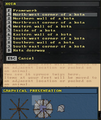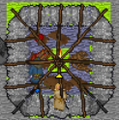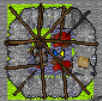Kota
A kota is a circular, conical tent or hut used by the Northern peoples (Owl-Tribe, Kuikka-tribe, Seal-Tribe) as homes in their villages or bases for their hunting camps.
It consists of a framework of slender tree trunks which hold up leather or furs from various large game, which then serve to keep the elements out. Kota usually have a fire in the center of the tent to help warm its occupants.
Unlike traditional wooden buildings, Kota are easy to create and quick to disassemble, making them ideal for temporary hunting camps or nomadic peoples. Unfortunately, they do not retain warmth in winter unless the covering used for them is fur (not leather), and furnishings such as fireplaces and sleeping bunks may not be built inside of them.
Contents
URW Game Encyclopedia description
The official URW in-game encyclopedia (accessed by the F1 key) describes the kota thusly:
A kota is similar to a large tent. All cultures know how to construct and use them, but they are most common among the northern people. The framework of a kota consists of several interlocking slender tree trunks. After that, they are covered by animal leather or fur to protect from rain and wind. The cover is then secured with more slender tree trunks. Reindeer leather is most common, but other large animals' pelt can also be used. In the cold of winter, a kota must be covered with fur to be warm enough to sleep in.
Kotas vary in size and are usually cone shaped. Larger kotas are used as dwellings, and can house a single person or even a family. Smaller ones can be used for a number of purposes, like storing goods or cooking. A fireplace is kept in the middle, with a hole in the center of the top of the kota for the smoke to escape. The back of the kota (opposite of the entrance) is considered sacred.
Resources and tools required
- 8 slender tree trunks (wooden pole framework)
- Leather (outer covering, i.e. walls) - for warmer conditions
- Fur (outer covering, i.e. walls) - for colder conditions
- Axe
Each piece of the kota requires a skin of greater than 7 pounds and an additional slender trunk..
Starting scenarios
If you choose The Village starting scenario, the scenario algorithm will sometimes place you in front of a 2x2 empty kota instead of an actual village.
Real life context
Goahti / Kota
The kota of UnReal World is inspired by the goahti, one of the main traditional types of dwelling used by the Saami of Norway, Sweden and Finland. Kota is the traditional Finnish name for the goahti, while in Swedish, it is known as kåta, and in Norwegian, gamme. Regional Saami dialects throghout northern Scandinavia refer to the dwelling variously as gábma, gåhte, gåhtie and gåetie.
The historical kota-s came in a variety of forms, but all shared a basic conical shape, held together from the inside with a thin support timberframe, consisting of pre-prepared wooden poles. Several of these poles featured simple drilled holes at their upper ends, for the purpose of easily slotting into each other and holding the overall frame together more tightly.
Once the basic kota frame was assembled, its owners could then start adding covering material to the outside, in order to enclose the small dwelling. The outer cover is where the forms of the kota differed the most:
- Some kota-s were simply covered with leather, hides, later also fabrics, and resembled large tents.
- Some kota-s received a cover of tightly packed wooden poles or boards, the completed abode resembling a wooden hut.
- Still, other kota-s were a type of turf hut, with a basic outside cover of wooden poles, and birch bark and peat added on top of that, the finished hut resembling a small sod house with an inner wooden frame.
The exact form of a specific kota would depend on the needs of a family and the surrounding environmental conditions. Wood-clad or tent-like kotas were popular in forested or clearing areas, while turf versions (often with enlarged and more robust timberframes) tended to be built in sparsely wooded, windswept places, or when a family needed extra living and storage space.
Though kota-s could be used as more permanent native housing, their internal frame and detachable outer covers made them fairly easy to disassemble, then transport to a new location and reassemble. Outer covers made of more heftier or permanent materials, such as wood or peat, were, of course, harder to transport by foot or by tamed reindeer.
Lavvu
A similar type of Saami dwelling is the lavvu. It shares a conical shape with the goahti/kota, but has a number of differences. These include a different support pole configuration, and an exterior covered exclusively with hide, leather, furs, and in more recent eras, also thick fabric or thick canvass.
In terms of appearance, the lavvu resembles a squater, shallower-angled equivalent of a Plain Indians' tipi tent from North America. Unlike kota-s, which were also usable for longer-term habitation (especially the wood-clad and turf versions), lavvu were used mainly as temporary tent dwellings during seasonal reindeer herding. They either appeared as solitary structures or as a part of small herder camps.
Terms for the laavu in Saami regional dialects include lávvu, låvdagoahte, láávu, kååvas, koavas. The Finnish language refers to them as umpilaavu, but occassionally kota, lumping them in with their typological cousin. Swedish refers to them as kåta (again, somewhat confusingly, the same term as kota). In Norwegian, they are called lavvo or sametelt, distinguishing them clearly as a separate type of dwelling.
Visual difference between a kota and a lavvu
Like the North American tipi, but unlike the kota, the lavvu's wooden poles intersect at one point above its roof and extend slightly further upward. The kota's poles don't intersect with each other in this fashion. Lavvu are also purely tent-like, while kota can have the appearance of either large tents or simple huts with more permanent walls.
Image links
- Images of historical and reconstructed Saami goahti (kota) - Image archive at Wikimedia Commons
- Images of historical and reconstructed Saami lavvu - Image archive at Wikimedia Commons
- Period photo (ca 1900) of a Saami camp with a kota (foreground, non-intersecting poles) and a lavvu (further back, with intersecting poles)
Gallery
A smaller and larger kota in a small Owl-Tribe village (summer time)
See also
- Buildings - General article on buildings.
- Building (Skill) - The skill that influences the building of structures.
- Settlement - An overview of settlement types appearing in the game, and variations in their architecture.





